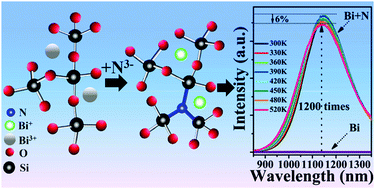Creating and stabilizing Bi NIR-emitting centers in low Bi content materials by topo-chemical reduction and tailoring of the local glass structure
Abstract
Bismuth (Bi) functionalized glass and fibers have been attracting much attention due to their super broad 1000–1700 nm emission and huge potential for use in new types of fiber lasers and optical amplifiers. Currently, Bi fiber lasers are achieved with only low Bi content fibers, which usually suffer from low absorption, weak emission and insufficient anti-thermal quenching. It remains unsolved how to intensify the Bi absorption and emission intensity for low Bi content materials and stabilize Bi active centers as the key to realizing the applications of Bi fibers and fiber lasers. Moreover, due to the co-existence of multiple Bi centers, the behavior of Bi near-infrared (NIR) centers remains unclear. Here, taking silicate glasses as a model glass system, we demonstrate the formation of Bi NIR centers and the intense enhancement of Bi NIR emission by the topo-chemical reduction of the Bi ions and the tailoring of the glass structure. By constructing a local reduction environment through the introduction of a nitride, dramatic changes, including highly intensified absorption and comparable emission intensity (∼1200 times), were achieved in low Bi content glass. We also observed excellent anti-thermal quenching behavior in this glass, which may be due to the strengthened glass structure resulting from the partial substitution of oxygen by nitrogen in the glass network. Furthermore, the same scenario can be reproduced in other typical glass systems. We believe that this work is helpful for improving the performance of existing Bi-doped glass and fibers with low Bi content, and our results also indicate that oxynitride glasses that exhibit a reduction effect and compact structure may present a new platform for high performance photonic glasses.



 Please wait while we load your content...
Please wait while we load your content...